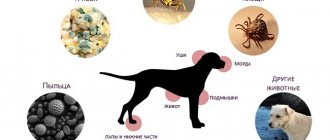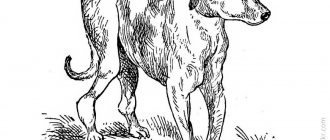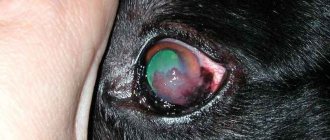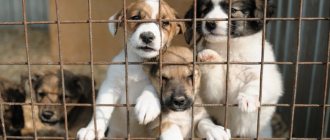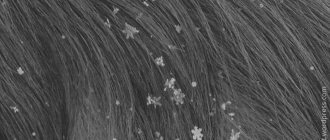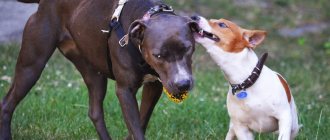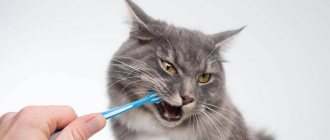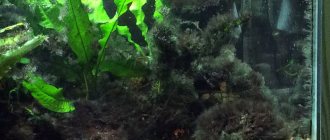Ringworm in dogs is a contagious skin disease that is difficult to treat and has a fungal or viral nature. If your pet suddenly begins to lose hair and strange red spots appear on its body, this is an alarm bell. It is possible that the dog has lichen, from which the animal may die if treatment is not started in time. What to do if you notice baldness and spots? How to quickly and effectively overcome an infection? How serious is it and can humans and other pets become infected from a dog? We will answer all these and other questions in our article.
What kind of disease is this
Ringworm is a group of skin diseases that have a similar clinical picture: rash, itching, inflammation and hair loss. Each type of pathology is caused by its own pathogen (fungi or virus), has its own causes, degree of infectiousness and methods of treatment.
Types of pathology
- Shingles (viral herpes). Viral skin disease. The causative agent is the herpes virus (Herpes zoster). The main places of localization are the abdomen and chest. The skin in the affected area is very itchy and painful. Dogs seek relief from suffering and itching and scratch the sore areas, introducing dirt and secondary infection into the wounds.
- Pityriasis versicolor (varicolored) does not cause suffering to pets. Visually, it looks like a small spot with a yellow, dried crust on a dog’s skin. The causative agent of the disease is yeast-like fungi. Over time, the crust changes color to brown. Most often, the paws and back of the dog are affected; it can be located on the animal’s neck.
- Ringworm is a non-contagious pathology. It develops as a consequence of allergic reactions to food. It can signal a sharp decrease in the dog’s immunity, and can also be a reaction to stressful situations. The second name of the pathology is weeping dermatitis. This type of lichen can become chronic. Visually it looks like bubbles on the skin filled with cloudy liquid. Over time, the bubbles burst and the liquid flows out. In the advanced stage, purulent mucus is released instead of fluid. Characterized by tissue swelling. The incubation period is 3-4 days.
- Ringworm (ring-shaped) is a contagious type of pathology. The infection is caused by the massive proliferation of two types of fungi: Microsporum and Trichophyton. Hair loss appears. The fur falls out in the form of oval spots, the area of which increases over time. If the proliferation of fungi is not stopped, lichen can cover the entire surface of the skin. Bald areas are very itchy. Itching irritates the animal and depresses its psyche. Dogs constantly scratch themselves, bringing dirt into the wounds. A fatal outcome cannot be ruled out. The incubation period of the disease is 3-12 days.
- Pityriasis rosea is not transmitted from dog to person. It differs from other types in that sick dogs do not experience severe discomfort with it. It looks like a small pink spot (1-3 cm). This pathology is considered an allergic reaction to viral infections. It affects dogs with weakened immune systems.
Important!
The incubation period for rosacea, herpes zoster and pityriasis versicolor is unknown.
Who is at risk
A healthy and strong immune system of a dog’s body is able to cope with the causative agents of lichen. But as soon as the animal’s immune system malfunctions, the risk of infection increases tenfold.
The risk group includes:
- puppies (up to 12 months), especially weakened and unvaccinated ones;
- dogs on an unsupervised walk;
- emaciated animals;
- pets who have had contact with stray animals;
- dogs during illness and recovery from serious illnesses;
- pets during the postoperative period;
- dogs with reduced immunity.
Routes of infection
Lichen spores can live in the external environment for several years. In addition, they are resistant to aggressive environments and some disinfectants. Therefore, the danger of fungal infection can lie in wait for a dog anywhere.
Main routes of infection:
- contact – from a sick animal (cat or dog);
- while walking – soil and plants can be inseminated with spores;
- through care items (combs);
- a person can bring fungal spores into the house on shoes or clothing.
Basic information about lichen
A dog can become infected with this dangerous disease almost anywhere:
- During a walk, the dog may come into contact with other animals that are carriers of the disease.
- While using various objects, for example, brushes or combs, which were previously used to comb out the fur of a sick animal.
- There are animals that are only carriers, but they do not show signs of lichen. Such a carrier could be your dog, or it could be the dog with whom he constantly plays. You won't even know that your pet is in contact with a sick animal.
So, as you understand, a dog can get lichen anywhere. Owners should understand that such a disease is unlikely to go away on its own. In general, the causative agents of lichen are quite tenacious and can remain in an active state for one and a half years. Quite often the question is raised about whether lichen is transmitted from dog to person. Unfortunately yes. Some types of lichen can be transmitted from animals to humans. Young children and people with weakened immune systems are especially susceptible to infection.
Experts identify several types of lichen in dogs: ringworm, pink, weeping and pityriasis versicolor. Each of them deserves special attention. Because symptoms and treatments vary.
Symptoms of lichen in a dog
Each type of lichen has its own symptoms. It is important to be attentive to your dog in order to notice warning signs in time and begin therapy.
General symptoms common to all species
- changes in taste preferences, dogs beg for sweets;
- apathy;
- sleep disorders;
- excitability;
- hyperthermia (except for herpes zoster);
- pale mucous membranes.
Symptoms of herpes zoster
- the appearance of large hairless areas on the neck, muzzle, back of the head and in the ear area;
- within a day, the spots swell and become inflamed;
- after a few days, the bald areas begin to itch and peel;
- If a dog scratches its receding hairline, secondary infection occurs, possibly suppuration and tissue necrosis.
Symptoms of pityriasis versicolor
- hyperthermia;
- large bald patches all over the dog’s body;
- the skin of bald areas changes color to bright pink or brown;
- peeling of the skin;
- Over time, bald patches begin to become wet and inflamed.
Symptoms of weeping lichen
- the appearance of large hairless spots in the tail or head area;
- severe itching, the dog itches;
- ichor oozes from the wounds;
- Over time, the wounds begin to bleed.
Ringworm - symptoms
- the appearance of “bald” oval-shaped areas throughout the animal’s body;
- severe itching;
- scratching the affected areas;
- Without treatment, bald patches begin to become wet and increase in area.
Pityriasis rosea - symptoms
- numerous hairless areas on the dog’s body, resembling a rash (size no more than 2 cm);
- redness of the affected areas;
- in the center of the spots the skin is yellow and peels;
- without treatment, the area of the spots increases, peeling and itching intensify.
Locations
Most often, lichen is localized in the head and neck area, on the limbs and around the tail of the dog. Typically, the first lesions appear on the animal's face and ears.
If proper treatment is not started in a timely manner, the pet will scratch itself, and the area of affected skin will gradually increase.
Allergy
The causes of allergic dermatitis and eczema in dogs are cosmetics or medicinal products, flea bites and other ectoparasites, plant pollen, household chemicals, and most often the cause can be found in the diet. Some dogs are prone to reactions to meat components of food, high content of certain grains in food, and chicken egg whites. The highest sensitivity is found in German and Central Asian shepherds, bulldogs, sharpeis, and dwarf decorative breeds. White and chocolate-colored dogs have an increased risk of developing allergies.
Allergy symptoms depend on the source. Thus, with intolerance to feed components, not only itching, rashes and redness on the skin can be observed, but also lacrimation, vomiting, and stool instability. The ears often become inflamed, and peculiar “effusions” may appear in the armpits, chest and groin area. With contact allergies, the most severe manifestations are observed at the site of application of a cosmetic or other product. If you are allergic to flea bites, the dog experiences severe itching in the sacrum area, and the parasites themselves can be found in the fur.
Identifying the cause of an allergy is often a long and expensive process. Be sure to get tested, their results are very important for making a diagnosis. Treatment may also not be effective the first time, since the doctor has to exclude many possible causes. In case of food allergies, various mono-diets are prescribed in order to identify and eliminate the negative component of the food. Be patient - even the most correct diet will not rid your pet’s body of the allergen in a day or two. Sometimes you have to wait weeks for a positive result. The reaction to flea bites also does not go away immediately after their destruction. It may take several days. A sign of recovery will be a gradual decrease in itching, a decrease in foci of inflammation and an improvement in the dog’s general condition.
As a quick fix, the veterinarian will usually prescribe antihistamines and, in particularly severe cases, corticosteroids. But in this way you can only suppress the symptoms. If the cause is not removed, the allergy will return.
Diagnosis of the disease
If you experience one or more symptoms that indicate your dog may have shingles, you should contact your veterinarian immediately. Only in a clinical setting can a diagnosis be confirmed or refuted.
Diagnostic measures:
- Initial examination. The doctor examines the dog and studies the symptoms.
- Wood's lamp diagnostics. Examination of the animal under a “black light” (Wood’s lamp). Fungi and some other microorganisms emit a fluorescent glow under this light source.
- Sowing a fungal culture. This study is necessary to make a final diagnosis. It is considered the most reliable. A scraping is taken from diseased areas of the animal's skin and placed in a special environment where lichen spores begin to actively grow.
What does ringworm look like in dogs?
near the ear
on the head
on the stomach
on the paw
Photo - what lichen looks like in a dog
Ringworm
Signs of lichen in dogs are quite difficult to miss. If you find the following manifestations on the skin of the entire animal, then most likely your pet has shingles:
- A balding spot appears on the skin, which becomes inflamed and gradually enlarges. If you touch it, you will feel that this spot is quite hot, moreover, it does not dry out and always remains wet.
- Then the affected area begins to become covered with a rash, which turns into small pustules.
- After some time, these small bubbles begin to burst, and the pus they contain comes out. This stage can already be considered advanced. Since the affected area becomes completely bald, and the entire skin is covered with purulent mucus, later a crust forms on this place, which is a dead stratum corneum of the skin.
If you ignore the appearance of such lesions, then soon your dog’s entire body will be covered with similar pustules. Their presence causes discomfort to the dog. She can lick these places, or she can scratch them until they bleed.
Usually, such lichen appears in those dogs whose owners do not pay enough attention to the dog’s hygiene: they do not bathe it, do not comb its hair, and feed it poorly.
It should be noted that this type of lichen cannot be transmitted from animals to humans.
Treatment at home - traditional methods
We present traditional medicine recipes for your reference and remind you that all of them do not have proven effectiveness. In addition, uncontrolled use of these products without the advice of a veterinarian can harm your pet. Be careful and attentive!
First method
What you will need:
- disposable medical gloves;
- laundry soap;
- cotton pads;
- iodine.
How to process:
- put on gloves and carefully trim the hair in areas affected by lichen;
- Make a saturated soap solution from laundry soap and warm water;
- treat sore areas with cotton pads, being careful not to hurt the dog;
- After this, treat the affected areas with iodine.
The procedure is repeated daily until the animal recovers. To prevent your dog from licking its wounds, use an Elizabethan collar.
Important!
Remember that iodine is toxic to animals, do not overuse self-medication!
Second method
What you will need:
- disposable medical gloves;
- cotton pads;
- Apple vinegar.
How to process:
- put on disposable gloves and trim the hair around the wounds;
- soak a cotton pad in apple cider vinegar and treat the affected areas;
- repeat the treatment daily until the shingles go away.
This method is only suitable for pityriasis rosea. Other types of pathology are not treated in this way.
Important!
If traditional medicine does not help, be sure to show your pet to a veterinarian, he will tell you how to treat lichen in dogs.
Video
Proper nutrition for your pet during treatment
In order for the body to have the strength to fight and help the medications work, you need to feed your pet properly. You definitely need to add vitamins to your diet.
The body takes everything valuable from the diet; if the dog gets sick, the menu is reviewed. Dry food is temporarily replaced with a medicinal variety, and an immunostimulating powder is added to natural food. The table should consist of a sufficient amount of proteins - this way the wounds will heal even faster.
More care is added to proper nutrition. Wounds are regularly treated and smeared with ointment.
Another side of care is the thorough cleaning of a house or apartment. Everything must be cleaned daily using disinfectants. Pet toys are washed thoroughly and regularly. Direct contact with other family members and other animals is excluded.
Professional treatment
The disease requires an integrated approach to treatment. The full course lasts from 6 to 8 weeks. This is due to the high survivability of fungal spores. It is impossible to completely cure a dog if you use only local treatment of the affected areas. To increase efficiency, treatment measures are carried out simultaneously with disinfection of the animal’s habitat and care items.
initial stage
While the area of the affected areas of the dog’s skin is not very large, it is enough to treat the affected areas with external antifungal and anti-inflammatory agents:
- creams;
- emulsions;
- ointments;
- sprays;
- shampoos.
Read more about popular external medications further in our article.
Severe (advanced) stage
In case of a large degree of damage and an advanced form of the pathology, it is necessary to give oral medications simultaneously with the treatment of diseased areas of the skin.
The most effective are:
- griseofulvin;
- ketoconazole;
- fluconazole;
- terbinafine;
- intraconazole
All these drugs are also used to treat humans. The veterinarian must select the product and calculate the permissible dosage.
Important!
Simultaneously with the treatment procedures, everything that the sick dog has come into contact with is disinfected.
External preparations – solutions, ointments, sprays
Ointment Yam Bk
A popular external fungicidal-bactericidal agent that has no analogues. It is highly effective against fungal diseases. It has been used in veterinary medicine for a long time. The product is low-toxic and safe for animals of all ages and conditions.
Contains: tar, salicylic acid, sulfur, turpentine, petroleum jelly, zinc oxide, creolin, lanolin.
How to use: apply a thin layer to the affected areas and around them (3-4 cm) with a special spatula 2-3 times a day for 7-10 days.
What it treats: ringworm, shingles.
Price: 20 mg pack. – 75 rub./18 UAH.
Fungin
A dermatological agent with an antifungal effect is available in the form of sprays and solutions. The main active ingredient is clotrimazole. The drug relieves the animal from itching and effectively destroys pathogenic cells. Has wound healing properties.
Contains: sulfur, glycerin, propolis.
How to use: the product is applied to and around the affected areas using a cotton swab or sterile gauze and gently rubbed into the skin. The procedure is repeated once a day for 10-14 days.
What it treats: ringworm, pityriasis versicolor.
Price: solution (30 ml.) – 310 rub./85 UAH; spray (30 ml.) – 415 RUR/115 UAH.
Clotrimazole
The antifungal agent is based on synthetic imidazole. The active component suppresses the proliferation of the fungus and causes its death.
How to use: Apply a thin layer of ointment to the affected areas of the skin, covering the area around them. The procedure is repeated 3-4 times a day for 3-4 weeks.
What it treats: pityriasis versicolor.
Price: tube (20 g.) – 185 rub./31 UAH.
Sanoderm
Complex action cream based on betamethasone, gentamicin and clotrimazole. It has antibacterial, anti-inflammatory and anti-allergenic effects. Effective against fungi.
How to use: apply a thin layer to affected areas 2 times a day for 2-4 weeks.
What it treats: ringworm.
Price: tube (15 g.) – 110 rub./55 UAH.
Fukortsin
The solution, popularly called “red brilliant green,” has an antiseptic and disinfectant effect. Contains: boric acid, phenol, acetone and resorcinol. The product is toxic and should not be licked off.
How to use: the affected areas are lubricated with the solution 3 times a day until complete healing.
What it treats: shingles, ringworm.
Price: bottle (25 ml.) – 40 rub./10 UAH.
Imaverol
An effective antifungal emulsion based on enilconazole. The active substance destroys fungal spores at the cellular level. Used in complex therapy. The product is safe, acts in the superficial layers of the skin, and is quickly removed.
How to use: before use, dilute the emulsion with boiled water at room temperature (1:50). The affected areas of the skin are treated with a cotton pad once every 4 days.
What it treats: ringworm.
Price: bottle (100 ml.) – 1450 rub./845 UAH.
Oral medications – capsules, tablets
Griseofulvin
Antifungal antibiotic based on the substance Griseofulvin. Has a cumulative effect. The active ingredient of the drug stops the proliferation of the fungus.
How to use: Give dogs 1 tablet 4 times a day during feeding. The course of treatment is 14-20 days.
What it treats: ringworm.
Price: pack (20 tablets) – 220 rub./45 UAH.
Ketoconazole
Tablets with antifungal, fungistatic and antiandrogenic effects. The drug is considered potent.
How to use: give to animals with food at a dosage of 5-10 mg/kg every 10-12 hours or once a day at a rate of 10-20 mg/kg.
What it treats: ringworm, weeping lichen.
Price: packaging (10 tablets) – 150 rub./130 UAH.
Fluconazole
A synthetic antifungal agent inhibits the activity of fungi. It is excreted unchanged through the dog's kidneys.
How to use: give to animals along with food at a dosage of 10-20 mg/kg 2 times a day.
What it treats: ringworm, weeping, pityriasis versicolor.
Price: packaging (10 tablets) – 35 rub./12 UAH.
Terbinafine
Tablets with pronounced antimycotic and anti-inflammatory effects are prescribed as part of complex therapy. Shows activity against pathogens of dermatomycosis.
How to use: give to animals with food once a day at a dosage of 20-30 mg/kg.
What it treats: pityriasis versicolor (lichen versicolor).
Price: pack (10 tablets) – 140 rub./45 UAH.
Intraconazole
The most effective medicine in the treatment of ringworm. Itraconazole suppresses the proliferation of the fungus and prevents it from developing. Available in capsule form.
How to use: give to animals with food once a day at a dosage of 10 mg/kg. The course of treatment is up to 1 month.
What it treats: ringworm.
Price: pack (14 drops) – 320 rub./43 UAH.
Therapeutic vaccines
The most effective in the treatment of lichen are therapeutic and prophylactic vaccines. For medicinal purposes, injections are given 2-3 times with an interval of 10-14 days.
The following drugs are used to vaccinate dogs:
- Polivac TM;
- Vakderm-F;
- Microderm.
How to know if treatment is helping
Signs indicating that therapy is effective:
- In the affected areas, crusts are actively separated.
- New fur begins to grow on the bald patches.
- Skin redness disappears.
- The itching goes away and the dog itches less.
It is possible to finally ensure that the treatment has achieved its goal only in a clinical setting. There, the dog is examined under a Wood's lamp and scrapings and cultures are taken. Only after two negative tests performed at monthly intervals can we talk about the dog’s complete healing.
External processing rules
All therapeutic measures must be carried out using rubber gloves and clothing, which can subsequently be treated with disinfectants or completely thrown away.
Processing stages:
- cut the hair, protruding a couple of centimeters beyond the affected area;
- remove easily detachable crusts and scabs. You can first soften them with warm soapy water or hydrogen peroxide;
- treat the affected areas and nearby healthy skin with medications;
- ensure conditions so that the animal does not lick off medications. For this purpose, special collars or muzzles can be used.
Removed crusts and clipped wool must be burned, since pathogens can adapt to the environment and survive for up to 18 months.
Is ringworm in dogs dangerous to human health?
Pink and weeping lichen does not pose any danger to humans and other pets. We have already mentioned this in our article.
Ringworm, shingles and pityriasis versicolor are contagious diseases. It is not dangerous only for absolutely healthy people with strong immunity. If a person’s immune system copes with the disease on its own, one can become infected and not notice it.
But for young children, people with compromised immunity, pregnant and lactating women, lichen poses a huge danger . Therefore, you need to take precautions when interacting with animals.
The danger of infection is not only from stray street dogs and sick animals. You can also get infected from pets if they are carriers of fungal spores.
Vaccinations against lichen
There are several vaccines against shingles. The best of them is considered “Vakderm”. Vaccination is recommended once a year. This way you can completely protect your pet from contracting this disease.
"Vakderm" is two vaccinations that are given at intervals of 1.5-2 weeks. Healthy dogs do not have any side effects after vaccination. If you vaccinate a sick animal, fungal lesions will appear on the skin, especially in those places where the infection has accumulated. But there is nothing to worry about, since after the repeated administration of the vaccine the animal will already be healthy.
Prevention
Prevention measures:
- Preventive vaccination against lichen.
- Never touch unfamiliar dogs and cats. Prohibit children from approaching stray dogs and cats.
- Maintain good hygiene. Wash your hands with antibacterial soap after each contact with the dog and its accessories, and upon returning from the street.
- Clean the hallway regularly with disinfectants.
- After each walk, wash your animal's paws and your shoes.
- Try to prevent your dog from coming into contact with stray animals.
- Follow quarantine measures if there is a sick animal in the house.
Vaccination against ringworm
Therapeutic and prophylactic vaccines (Polivak TM, Vakderm-F, Microderm) are used both as part of therapy and for prevention.
How is vaccination carried out:
- 10-14 days before vaccination, the animal is treated with anti-parasitics;
- the first vaccine is administered at the age of 2-3 months;
- after 10-14 days the procedure is repeated;
- the first 3-5 days after vaccination the dog is freed from physical activity;
- revaccination is carried out after 1 year.
Recommendations for caring for a sick pet
Personal hygiene is mandatory in case of infectious diseases, along with patient isolation. Immediately after contact with a sick animal, it is necessary to use disinfectants; it is possible to take vitamins and antifungal drugs.
Regular wet cleaning of the premises is necessary. Items that the pet has come into contact with should be disposed of whenever possible.
The diet should be balanced; the benefits of vitamins have already been mentioned above. It is advisable to confirm the diet with your doctor.
Be sure to follow all veterinarian instructions and monitor your sick pet.
Dog Owner Stories
Valeria: “My shepherd dog developed some kind of black crust on his nose, then the hair in this area began to fall out. The vet diagnosed it as ringworm. We were prescribed Imaverol. They told me to treat the affected area of the nose once every 3-4 days for 2 months. They also prescribed Clotrimazole ointment to smear my nose with. Additionally, they advised to give the dog vitamins. After the first treatment with Imaverol, the dog’s nose turned red and there was ichor in some places. It scared us. But, after 3 days everything began to dry out, and a week later new hairs of fur began to appear on the nose. We managed to completely get rid of lichen in 1.5 months.”
Sergey: “My Yorkie got shingles after the show. We received 2 Microderm injections. One was done immediately at the appointment, the second was done 10 days later. During breaks, I treated the affected areas with Yam ointment. We got rid of this infection quite quickly. During the treatment period, we went with the dog to live in the country so as not to infect the children and the cat.”
Marina: “I always thought that only cats have lichen. Therefore, I didn’t pay much attention when my dog’s hair began to fall out around his eye and redness appeared. The first days I lubricated this area with iodine. It seemed to me that this would be right. But when, after a week, the spot began to increase in size, and the dog began to try to scratch the eye, I got scared. My husband and I took her to the vet. Only there I found out that it was lichen. The doctor immediately prescribed Itraconazole tablets and forbade me to smear the area with iodine. Instead of iodine, he advised treating the wound with Fukortsin. We were treated for almost 2 months. If I had known earlier how dogs get lichen, we would have cured the dog faster.”
Causes, symptoms and treatment
Ringworm in dogs, as already mentioned, can be caused by improper dog hygiene. First of all, you should give your pet a good bath; if there are fleas on his body, then you need to get rid of them immediately. After completing the course of treatment, the dog must be clean and comfortable so that a relapse does not occur.
In some cases, ringworm occurs due to the dog's poor diet. In this case, you need to remember what you fed the animal and tell the veterinarian about its diet. You should immediately exclude all fatty foods from the menu, as well as foods that contain starch. Perhaps the doctor will prescribe a diet for your pet and also prescribe a complex of vitamins.
In treatment, it is necessary not only to establish the cause and get rid of the causative agents of the disease. It will also not be possible to do without the use of external agents. It is better to treat damaged areas with zinc, ichthyol or sulfur-tar ointment. Also an excellent remedy is Yam BK ointment. These products will dry out the skin so that the wounds heal faster.

